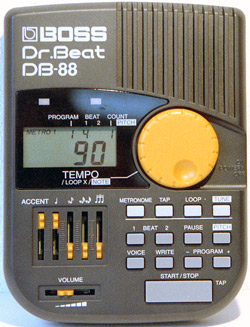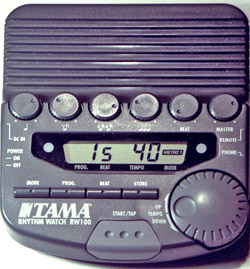The Metronome Page

BOSS Dr. Beat DB88

Tama Rhythm Watch RW100
Here we see the two most advanced electronic metronomes currently available (2002). Both have more or less the same possibilities. To select the model that suits you best I have setup this page.
You'll find some General Info and Newsrmation about metronomes and I'll present to you a series of exercises to do with the help of a metronome.
2008: I'm investigating the models that have been released recently. You can expect the result here.
A comparison of features |
||
|---|---|---|
| Boss DB88 | Tama Rhythm Watch | |
| Battery power | 9 volt | 9 volt |
| AC Adaptor (not included) | Boss PSA series (centre = +) | centre = + |
| Tempo range | 35-250 | 35-250 |
| Headphone jacks | mini and normal | normal |
| Memories | 8 | 20 |
| Generators | 2 | 1 |
| LCD display |
|
|
| Leds | pulse and accent | pulse and accent |
| Accents |
|
0,1,2,3,4,5,6 |
| Subdivision |
|
|
| Volume control | every subdivision (slider) | every subdivision (turn knob) |
| Master volume | Yes (slider) | Yes (turn knob) |
| Input jack | Standard guitar jack | No |
| Pitch generator |
Yes (C2-B6)
A4=438-445 Hz |
No |
| Remote control | No | Yes |
| Cymbal stand connector | Yes | Yes |
| Table stand | Yes | No |
| Loop function | Yes | No |
| Tap function | Yes | Yes |
| Pause function | Yes (in loop mode) | No |
| Metronome sounds | 3 (including voice) | 2 |
Both metronomes operate in pretty much the same way. An on/off switch brings the metronome to life. Here we see the first difference:
- Boss returns to the last used (stored) setting,
- Tama always puts you in 4/4 at 120 BPM!
The tempo can be set -in steps of 1- with the large turning knob. It works the same on both metronomes, but on the Boss you can reset the tempo to 120 by pressing one of the other keys while turning the wheel.
The Tama has 20 programmable memories, but you can only select the next higher one in an endless loop. If you have memory 3 playing and want to go back to number 2, you have to cycle al the way up 4,5,6...20,1,2 to get there.
Boss has an up/down pair of switches but only 8 memories.
The click sound can be selected, Tama has two different sounds, Boss has also two sounds and a voice that is counting (or is she shouting?)
The two sounds are a woodblock type (mellow) sound and a more ìclickierî sound. The accent (every 1,2,3,4,5 or 6 beats on the Tama and 1 - 8 on the Boss) is clearly to hear and has its own volume control.
There is a master volume control on both machines which works as expected.
Every beat can be subdivided in 2, 3 or 4. The subdivision into 4 only gives you the second and fourth note of that subdivision, but together with the 8th note subdivision you can have real 16th notes.
The tap mode works alike on both: you tap the start/stop button which acts as a tempo sensitive device for measuring the time between successive hits. It works between tempo 35-240.
You can connect a headphone to each metronome. The Boss has an extra mini jack connector.
The internal speaker is disconnected when using the phones.
Both metronomes run on an internal 9 volt battery. Power use is quite high and you can expect to replace batteries often. Therefor, use of an external power supply is recommended (by me, that is). But both metronomes use different systems! Boss has the negative on the inner pole, Tama the positive on the inner pole! Donít use the wrong one!
So far for what both machines -more or less- have in common.
Let's take a closer look at their differences.
Odd Meters
On both metronomes you can program different meters in a simple way: You just put the accent to sound every 2 - 6 (Boss: 8) beats. This is also the only way to do it on the Tama. The Boss gives you a more advanced way of programming real odd meters by means of having available two independent generators that each one can be programmed to have an accent every 1 - 8 beats. And you can combine those two generators (called beat 1 and beat 2) to set up complex meters. If you set beat 1 to sound a 3/4 bar and beat 2 to sound a 4/4 bar, you have a real 7/4 bar with it's proper subdivision and real accents.
If we define a simple odd meter to be any combination of two odd bars or one even and one odd bar, then you can set up all the simple odd meters that are made up of the figures 1 - 8 (e.g. 1 + 1, 1 + 2, 1 + 3, ..., 1 + 8, 2 + 3, 2 + 5,..., 7 + 8). But if you want to have the subdivision of 3 + 4 + 3 + 2 + 3, it cannot be done in that way.
But now we turn to the looping feature of the Boss: You can set up any of the 8 memories with a different beat combination and then make a selection of which memories you want to replay, having the option of repeating each bar (memory) 0 - 250 times. The zero is important, that's the way to skip a memory position. This function has one weak point however, you can only replay the memories in the order 1 - 8 (or skip any in that range) but you cannot replay m1, m2, m5, m4, m3 for instance. Also you cannot use one of the memories a second time: m1, m2, m1, m3 is impossible.
All the settings of a given beat (tempo, accent, level, subdivision) are stored in memory (The Tama stores only the tempo), making it easy to program tricky tempo changes. When you playback in Loop mode, you cannot change any of the parameters.
If you playback in normal (metronome) mode you select which one to play and then you can change any of the set parameters and write them back into memory or only change them temporarily. If you don't write back the changes, the next time you select that memory you'll get it unchanged again.
The Tapfunction
You switch both metronomes into tap mode with a button and then you use the start/stop button as a tapping device. The response and feel of the Boss button is easier and more direct in my opinion. The Tama has to be pressed harder to get measured, sometimes leading to "missing the beat".The Boss measures the time between any two taps, regardless of the setting of the metronome. The Tama takes the metronome setting into account. E.g. if you have a 4/4 bar programmed, it only displays the tempo in tap mode after you have tapped at least a 4/4 bar!
Simply said: on the Boss you can always read the tempo after two taps, on the Tama you have to adjust the meter to get the same effect.
Loudness control
The faders of the volume control on the Boss seem to be the weakest point compared to the more robust turning knobs on the Tama.
One thing that you have to get used to with the Boss metronome is the fact that, once you have stored a certain rhythm in one of the memories (including loudness of the master fader as well as the subdivision and accent faders) and replay that rhythm later after you made changes to one or more of the faders, the faders don't go back to the corresponding position! The faders are not motor operated! This can lead to the confusing situation that you have all the faders in their zero position and still hear a sound!
The Boss has as one of it's sounds the sound of a woman voice that "shouts" instead of making a click sound. Under certain circumstances this might be more appropriate than the regular click, because it leads you thru longer patterns more easily without getting lost. But be aware of the higher power consumption.
The LCD Display
The LCD display on both metronomes is of good quality and clearly visible.
The Tama is pretty straightforward with its information: you can read the tempo (both in metronome and tap mode), program number (0-20) and accent (0-6). Also the current mode is visible: Sound 1, Sound 2 and Tap.
The DB88 has more functions and hence its display contains far more information.
Off course you can read the tempo, but also the name of the tone when in tune-mode and the number of repetitions in loop-mode.
Because you have two generators (called Beat 1 and Beat 2) you can see for each one what its settings are: 1-8 for Beat 1 and 0-8 for Beat 2. Finally you can see what the current count is, it cycles in step with the click (suppose it didn't!)
Bits and Pieces.
The Boss has an extra functionality by being a tuning device as well. The reference pitch for note A4 can be set anywhere between 438 and 445 Hz in 1 Hz increments. The total range is from C2 to B6. You can store selected notes in 8 memories, independent from the rhythm memories. The Boss also has a table stand (included) and an extra input jack makes it possible to plug any instrument in (e.g. guitar), so that you can hear both instrument and click thru the speaker or the headphones.
The fact that you can plug in headphones with normal and mini jack is a user friendly extra.
Each metronome can also be used in Silent Mode: no sound at all and just two leds that guide you trough tempo and accent. On the Tama the both leds are alternating on/off in green color with the chosen accent (1-6) as a red color.
The Boss has also two leds, always red and one is always showing the pulse while the other only shows the accent (1-8). If you play both generators (in complex or odd meters) the leds show also the correct accent for the second generator.
Conclusion
Being a newer device, the Boss DB88 seems to be the right choice for almost all situations. However, if you need 20 programmable memories for on-stage reference and the ability to switch them with a foot operated device (not included), you should go for the Tama. If money is your first concern, you don't care about odd-meters and an easy to use multifunctional metronome is all you need, than the Tama is also your choice. Do you need the odd-meters and the looping function, you have no choice but the Boss DB88.If you go for the DB88, I strongly advice you to buy the external power supply as well.